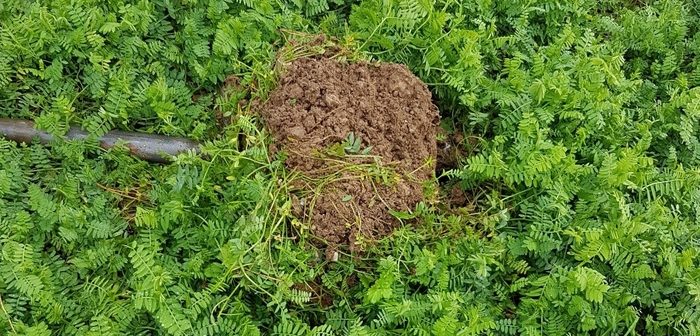Growing phacelia or oil radish cover crops in vegetable rotations helps to build and stabilise soils – with a new trial revealing it could safeguard future productivity.
The trial – funded by Agri-Tech Cornwall with land provided by Duchy College – found that phacelia and oil radish outperformed 24 other species and varieties of cover crop, including legumes and oats.
Where a break from brassicas is required, phacelia proved to have the best results – whether sown in spring, summer, or autumn – for improving soil organic matter. In contrast, where a break from brassicas is not required, oil radish gave the greatest above ground biomass, improving carbon and nitrogen sequestration.
“With increased industry pressure on sustainable food production and more frequent extremes of weather, growers are seeking more ways to preserve their soils,” says Ian Boase, vegetable specialist at Elsoms Seeds, and manager of the independently assessed trial.
Crucial for soil structure
“Soil Organic Matter (SOM) plays a crucial role in improving soil structure, health and capacity for carbon, nitrogen, and water storage. An incorporated residue from cover crop biomass is a very effective way of getting organic matter back into soils between cultivations.”
In the trial, both phacelia and oil radish produced a lot of biomass, with tangible improvements in terms of nitrogen and carbon sequestration, nutrients in green material, and feed for the following crop.
“At >61 days after March drilling, phacelia and oil radish produced 40t/ha and 35t/ha respectively of above ground biomass – each sequestering around 15t/ha of carbon and 500kg/ha of nitrogen,” explains Mr Boase.
He estimates that between one third and half (166kg – 250kg/ha) of that nitrogen could be available to the next crop, but further trials are required to quantify this.
“The fixation of plant available nitrogen from these crops is of particular interest,” he says. “Where growers may be inclined to look at legumes like clover for nitrogen fixation, the trial has identified a critical limitation; they simply can’t establish quickly enough within a minimum 12-week rotation break.”
Another limitation is predation by pests. “Egyptian clover was the worst affected by predation with 80% damage,” says Mr Boase. “Phacelia and oil radish were less affected, with recorded damage statistically irrelevant.”
The trial also considered ground cover and crop height; the former an indicator of weed suppression efficacy. Here, oil radish triumphed, reliably covering ground across all three sowing windows. The latter, influencing means of crop destruction and residue incorporation, proved a more complicated matter for growers, as oil radish exceeds 20cm in height.
“Single pass systems are increasingly popular, used to reduce soil disturbance and to keep cover crop costs low,” he explains. “However, the equipment used in single pass systems is designed to go over cereal stubble, so cover crops with residues higher than 20cm are likely to tangle and be problematic.”
As a consequence, growers in these systems will need to favour short cover crops, or ones that are killed over winter for ease of incorporation.
Ultimately, the grower needs to know what they want to achieve with a cover crop, says Mr Boase. This may be increasing soil organic matter and nutrient capture, improving soil structure and crop yields, preventing soil erosion or reducing fertiliser inputs. “Once decided then you can look at your rotations, available cover crops and destruction method.”
Keeping costs down is also important, which was reflected in the trial. “We didn’t apply any fertiliser, plant protection products, or weed control so it achieved what all growers will be aiming for; low cost.”
However, the trial results are not the end of the work. The overarching purpose was to identify which species would be suitable for further data analysis and investigation into commercial viability, particularly for vegetable rotations in South-West England. “In this region land is rented on long term tenancies – we also want to look at whether the new environmental schemes on offer could be applicable,” says Mr Boase.
“We can now explore further, like how much the top performing crops could raise SOM levels and what that means for soil structure and water holding capacity. We can also gain a deeper understanding of increases in follow-on crop yields – whether through greater nutrient release or reductions in crop pressures like weeds, pests and disease.”
Trial protocol
The trial assessed 26 cover crop species and varieties on objectives like biomass production (residue), carbon nitrogen ratio and sequestration, crop height, ground cover and pest damage. Each of these is valuable in determining production and commercial compatibility.
The cover crops were drilled during the three main vegetable break periods; February to March; mid-August to mid-September; and October. Each had 12 weeks between drilling and destruction, emulating the shortest period possible between rotations.
The trial was independently assessed by Reading University and Duchy College researcher Hannah Jones, with Ian Boase managing the project and assisting in the field.
Each plot was drilled at a standard depth into a randomised plot design at a mid-range seed rate. Every variety was repeated three times, producing 78 plots per period, each measuring 10.57m₂.
At present there is no set date for publication of the full results, but data and experience gained in the initial trials and from further investigations will be used to help inform the market.




